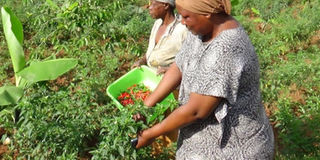Farmer earns big from pepper

Muyobo picks red pepper in her garden. The farmer is determined to expand her farm. Photo by David Wandega
They call her Mama pilipili and Zaina Muyobo Nambuya, 52, likes it for she stands out among farmers in Manafwa District.
Getting into red pepper business was the last thing she thought she would ever do.
Muyobo always wanted to be a successful maize farmer but fate pushed her into growing red pepper.
Starting
In 2014, the farmer bought three acres of land in for Khabutoola Sub-county, where she had planned to move from Manafwa Town and grow maize.
Muyobo, who is also a politician, started growing red pepper as a hobby three years ago.
Elders, however, allocated her land bordering a thicket that is infested with wild animals.
This made it difficult for her to grow the maize. However, giving up was not an option for her. Muyobo went into pepper farming after learning several animals, save forbirds keep off the crop.
“A friend advised me that pepper was the only crop that wild animals would not touch. This encouraged me to plant it,” she recalls.
Turning point
“One of my friends had planted pepper on his farm to help ward off wild animals from other plants. He demonstrated to me the way to grow the crop and I was impressed. I decided to copy his style of farming which I did to perfection.”
Since then, Muyobo has never turned back. The mother of three now produces pepper that she describes as “sweet, spicy and hot”.
According to her, pepper is easy to grow and preserve as long as the climatic conditions are favourable.
“My first harvest was a bumper, thanks to my friend’s guidance. He later helped me find market when I thought I would make losses. This encouraged me,” narrates the farmer, adding that pepper matures into scarlet red in about 70 days.
Capital
Muyobo’s start-up capital was Shs2 million which she, among others, used to buy seeds and pay labour.
Prices
Muyobo earns Shs7.4 million, from a tonne of pepper. Prices range between Shs5,550 and Shs6,660 a kilogramme.
Challenges
Among the challenges she faces are high cost of fertiliser and pesticides.
Muyobo also wishes that the government would introduce agricultural extension officers in the pepper sector to help farmers benefit from the crop.
“We need experts to advise us on best practices and how to use pesticides. Sometimes pests attack my crop and the only thing I think of doing is to uproot them,” she says.
Muyobo trains other farmers to help them join the pepper business.
“If we have many people growing the crop, it would be easier for buyers to come and buy the produce from farm. This will save me transport costs that I incur by taking my produce to the market,” she says.
The farmer sells her produce to vendors in major towns including Jinja, Mbale, Tororo, Iganga and companies such as KK Fresh Produce Exporters Ltd.
Harvest
Muyobo says she harvests up to 600 kilogrammes of green pepper and about 400 kilogrammes of scarlet red pepper in two-and-a-half months. After planting, the crop can be harvested for two years before another is grown.
“We practise rotational farming to improve soil quality. We do not inter-crop pepper with maize or sim-sim since it grows well on its own,” she explains. At the farm, Muyobo has a nursery where they plant pepper seeds before transferring the seedlings to the main farm. “You have to take good care of the young crops in the nursery to avoid losses. In our case, we have used old mosquito nets to cover the nursery because we do not have other material. The nets keep away birds and other pests,” says Muyobo.
Pepper farming has spared Muyobo the competition she would have faced growing maize.
“Pepper earns me a living. People used to tell me I would not get market, now they have seen it is a profitable venture. As they cry selling their maize at giveaway prices, I am making loads of money from pepper,” says Muyobo. According to her, pepper is easy to grow and preserve as long as the climatic conditions are favourable. She adds that red pepper has stable and better prices, which favours the farmers compared to other crops such as maize, beans, and soybeans whose prices have drop suddenly.
“This crop has got long seasonal harvest, stable and good prices compared to other crops,” she says.




